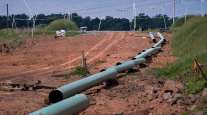Tanker Wetlines Rule Advances
This story appears in the Oct. 25 print edition of Transport Topics.
PHOENIX — The Pipeline and Hazardous Materials Safety Administration sent its new proposed “wetlines” regulation to the White House Office of Management and Budget on Oct. 15 for review.
While details are still unknown, the regulation is expected to require haulers of gasoline and other petroleum products to purge the piping under their trailers of the small amount of product that remains in those lines after a delivery.
Tank truck executives, as well as law enforcement officials, have said they are concerned that the proposal could be very costly to comply with and potentially dangerous for maintenance workers and inspectors.
Congress and the National Transportation Safety Board have been pushing for such a rule for many years because of their concerns that the wetlines could cause a serious fire if they are ruptured in a crash.
In 2006, PHMSA withdrew an earlier attempt to require the draining of wetlines in favor of a cooperative effort with industry.
Last year, the agency said it was reviving the proposal and would seek to apply it to new and existing equipment (click here for previous story).
“We think this is dangerous work to do a retrofit,” Dan Furth, vice president of the National Tank Truck Carriers, told Transport Topics here during American Trucking Associations’ Management Conference & Exhibition. “Vapors are more dangerous than the actual product, and if there’s a rush to retrofit 27,000 to 30,000 of these trailers [because of a new rule], then you’re going to have a king-sized problem.”
Barbara Windsor, the new ATA chairman and president of Hahn Transportation Inc., a Maryland-based tank truck fleet, said there were other ways to deal with the wetlines issue, such as purging at the loading rack. She also said removing the potentially flammable product in the lines didn’t necessarily diminish the risk.
“You’re not going to get close to the wetlines” unless a vehicle strikes a tanker directly in the center during an accident, she said.
Furth said NTTC also believed that the costs of complying with the regulation would be greater than regulators have suggested.
Stephen Keppler, executive director of the Commercial Motor Vehicle Safety Alliance, said the law enforcement group believes the rule could put inspectors in jeopardy.
“To expect officers to go and inspect wetlines at the roadside — that could be a real problem,” he said.
OMB has as long as 90 days to review the proposal before it is published in the Federal Register, likely in mid-December.




